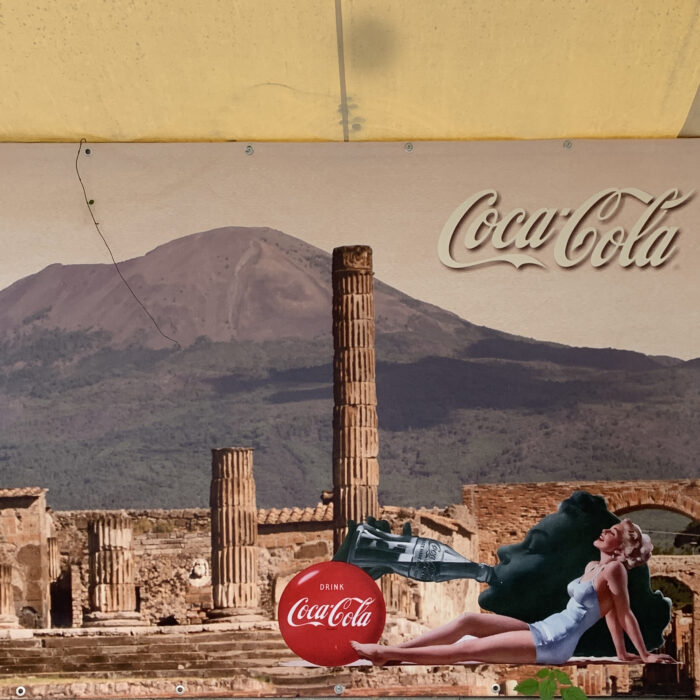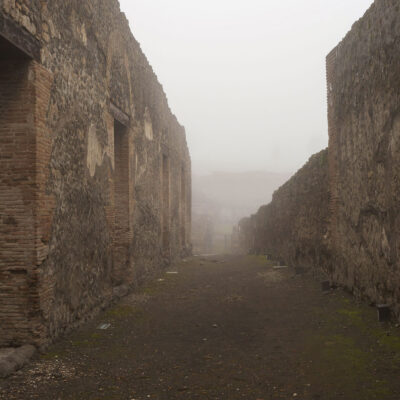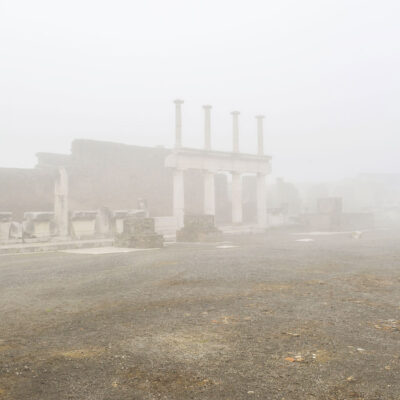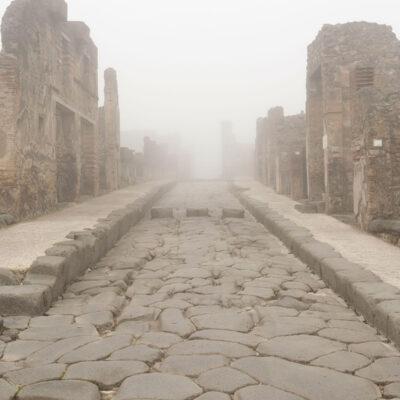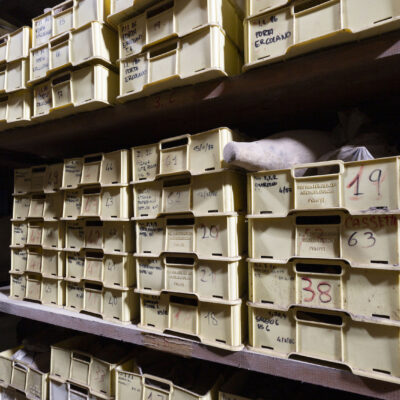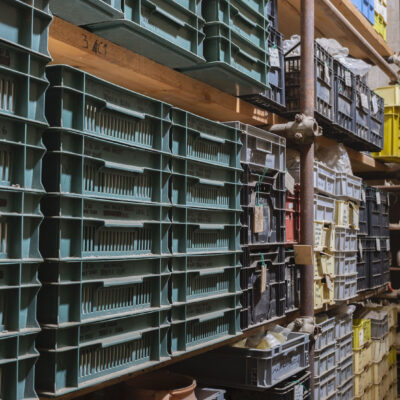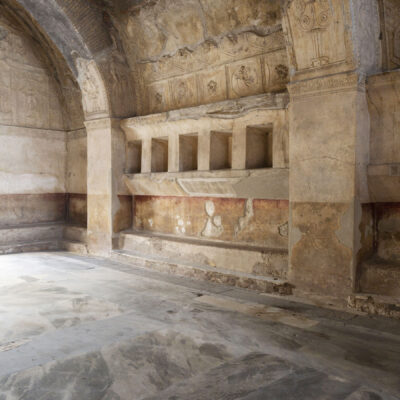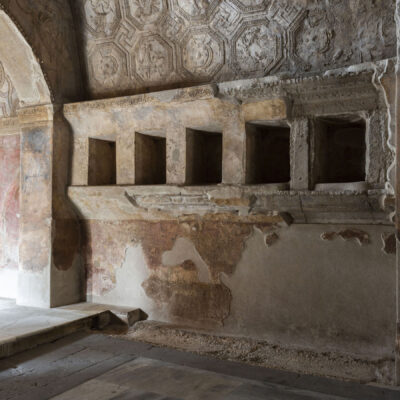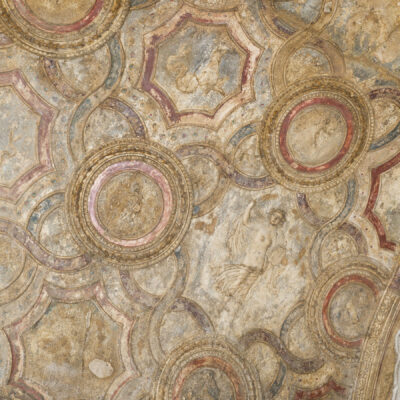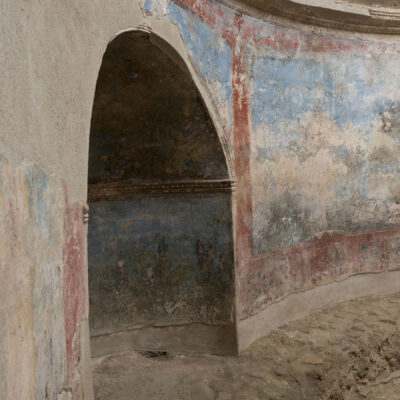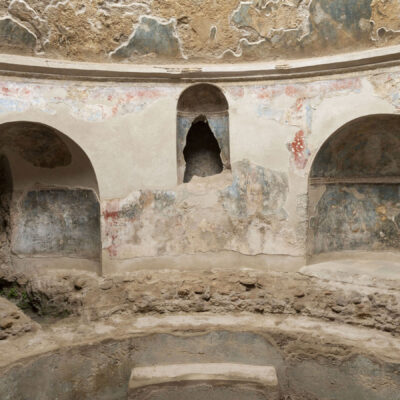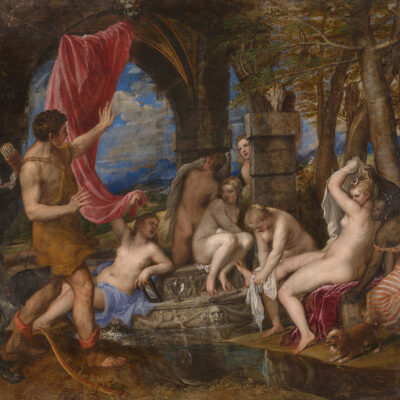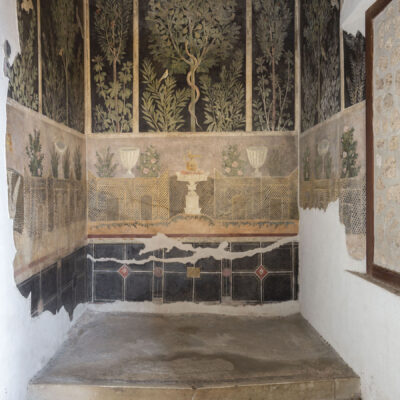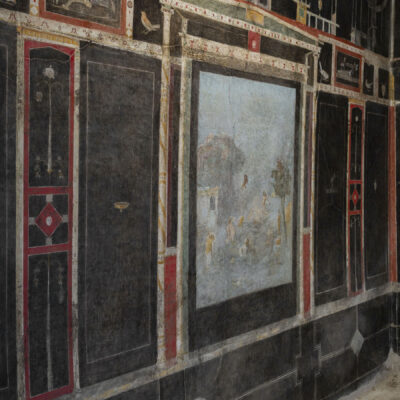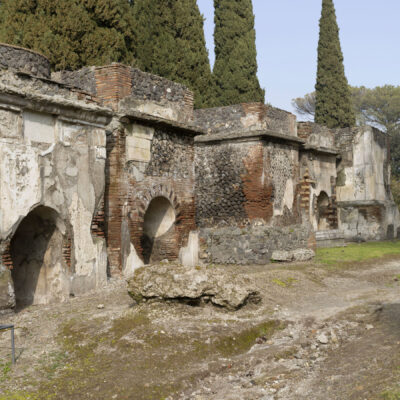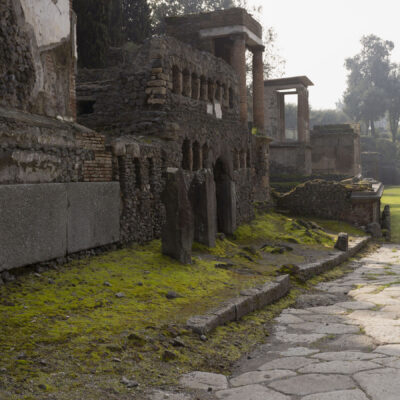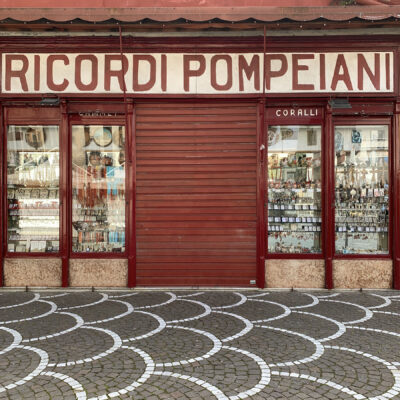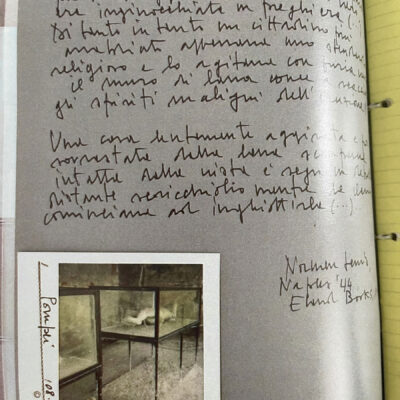Pompeii Commitment
Negar Azimi and Giovanna Silva. Letters VI 16, VI 20
Commitments 19 20•05•2021To: Negar Azimi <n*****@gmail.com>
My dear Negar,
I arrived in Naples today.
From the train window, I could see Vesuvius in the distance. The sight of it brings up old memories, fantastical tales from primary school about people and pets forever frozen in ash. It also reminds me of childhood Latin class, the word “Vesuvius” often the only word I could recognize in an otherwise inscrutable sentence. I hated Latin. I preferred Greek.
Did I ever tell you that I wrote my thesis at university on this volcano? I spent a whole year in Naples, trying to understand how people might survive another major eruption. I suppose I was playing the young and modern Plinius, studying Vesuvius from afar. Luckily, I didn’t suffer the same fate he did.
For me, Pompeii was and continues to be the most vivid example of mass tragedy I know. Coming back years later in the midst of this annus horribilis, I’m once again reminded of life’s unpredictabilities.
I’m here to visit the site, and its archives. The site is closed to the public, but fortunately Laura is going to let me in. Can you imagine walking around an empty city, as if stuck in another century, another time? I’m thrilled to be here.
It’s been exactly one year since you and I started our conversation, and I want to share this experience with you.
We’ve talked about Italy a lot, and we’ve walked around my city, Milan. I know that you’ve never been to Pompeii, so I hope that you might begin to experience this story, this place, all these fresh and buried memories, through my photos. As if you were walking with me.
G
To: giovanna silva <g*****@gmail.com>
Dear Giovanna,
I’m imagining you arriving in Pompeii, the summit of Mount Vesuvius coming into view like an upside-down ice cream cone with its bottom fallen out.
You did tell me that you wrote your thesis on Vesuvius in one of our earliest exchanges. You told me that if you were ever to get a tattoo, it would be of a volcano. Then you asked me if I have a tattoo. The conversation zigzagged from there and may or may not have included a thought about how both Emily Dickinson and Virginia Woolf made adjectives out of the volcano, as in a “vesuvian face,” pace Dickinson. Her poems are full of volcanic imagery. Metaphors, probably, for her stifled but bubbling sensuality. Can you imagine a vesuvian face? I’m trying to.
I’ll try to imagine you as the reincarnation of Plinius. But did you mean the younger or the elder? From what I understand, the elder was a savant and naturalist and polymath — a little like your beloved Alexander von Humboldt. Apparently, he died while choking on volcanic ash, but not before communicating that he had seen a cloud of “unusual size and appearance” in the shape of the umbrella pines of Rome. Or did you mean Pliny the younger, who offered up the only eyewitness account of the eruption that we have in his letters? I’ve always thought that letters are the most perfect art. I think you might agree.
I suppose that for Italians, Pompeii is shorthand for the unthinkable. Apropos the unthinkable, I wrote to you last March just as Milan was declared the epicenter of the European pandemic. I was in sleepy Los Angeles, unbelieving that the horror would eventually spread to those shores, too. You were locked in your apartment, restless, a hamster spinning in her wheel. I wondered how you were faring.
I didn’t tell you, but a few weeks ago I started consulting a psychic. Okay, she’s not really a psychic, but a spiritual teacher and shaman with an extravagant name and an even more extravagant accent. Without knowing much about me, and certainly not knowing about this letter exchange, she told me that I would soon be alighting in Italy. I told her that I had no such plans to be in Italy and left it at that. And yet here I am, poised to visit Pompeii, with you as my proxy.
There’s a lot more to say, but first, I’m looking forward to receiving photographs of your view. Without all the chatty thick-calved American tourists, et al. What a dream!
Negar
To: Negar Azimi <n*****@gmail.com>
Dear Negar,
This morning I woke up and found Naples wrapped in a thick fog. This gave my visit a special twist. I’m from the city of fog; Milan is often dismissed as an ugly, fog-filled place. At football games, one of the chants against our teams is C’avete solo la nebbia, or ‘You have only the fog.’ In other words, I’m used to it. It was amusing to see surprised Neapolitans waking to this surreal atmosphere. Naples is normally so hectic and noisy, but suddenly, it looked to me as if everything had been dipped in whipped cream, smothered in silence.
I met Laura at the train station. The station was empty and we jumped onto the circumvesuviana, the same shitty old train I used to take while I was living in San Giovanni Teduccio during my thesis year. We chatted about our lives while the landscape outside flew by, glimpses of the modern city at the foot of Vesuvius occasionally coming into view.
We were the only people to get out at the Pompeii stop and immediately noticed that all of the touristic shops, usually overflowing with people, were closed. My attention was caught by a Coca-Cola sign, presumably a copy of an old advertisement, featuring a curvy blonde woman from the 1950s. She’s sun bathing in front of the ruins, and the Coca-Cola logo sits next to her naked feet.
Love,
G
PS I was Pliny the Elder, of course!
To: giovanna silva <g*****@gmail.com>
Dear Giovanna,
I’m looking at that Coca-Cola advert and reminded that the octopus of capitalism knows no limits. The monetization of heritage is relentless, isn’t it?
For the past year, I’ve been looking at your photographs of cities emptied of their habitual protagonists, like a stage play in which the actors haven’t show up, but the set remains intact. Is Venice Venice without its tourists? It’s a real question. I have a feeling you might say yes, but I’m not sure that I agree. I’m partial to — even if annoyed by — the selfie sticks and squawking bucket-list obsessed foreigners that are a part of so many of the cities we love.
You and I both love Egypt. I remember going to the pyramids just after the 2011 revolution and finding no one there save a few desperate men haranguing me to take rides on their emaciated camels for mere pennies. It made me cry.
I can’t wait to see how you find Pompeii changed after all these years. That fog seems to conjure time travel.
Negar
To: Negar Azimi <n*****@gmail.com>
Dear Negar,
Let me try to recreate our arrival.
We were alone at the site, so alone that we could hear the sound of our own bodies. Because of the fog, we couldn’t see further than two meters ahead. The volcano, usually so present, was missing. Where was Vesuvius?
I’m trying to find the words to communicate the feeling of being there.
When I was a child, I wanted to be Indiana Jones. The fantasy never really faded away. I’m attracted to adventure, to living on the edge of danger, even if I’m actually not brave at all.
You mentioned Egypt. It’s funny, because I once had a similar sensation while visiting the pyramid at Dahshur. I had entered the pyramid alone, crawling on my hands and knees through a passage where I could barely breath, filled as it was with the thick stench of ammonia. I imagined all the people who had passed through before me, for millennia. As I moved ahead, the corridor grew more and more narrow, until I could no longer see the entrance. I had a thought: what would happen if someone closed the door behind me? I’d be stuck there. Forever.
This mix of excitement and fear marked my entrance to Pompeii.
G
To: giovanna silva <g*****@gmail.com>
Dear Giovanna,
Pompeii without Vesuvius is a disaster without a point of origin, a body missing its head. Andy Warhol without the “money shot.” Imagine stumbling upon this place without knowledge of the volcano, trying to piece together what came to be, how a town came to be buried under twenty-three feet of ash. A mystery and a quest. A little like a complex poem to decipher.
I only recently learned that the Italian word for fog is nebbia. I’m not a linguist, but it’s obviously not far from the English word “nebulous,” as in hazy, unclear, ill-defined. Wouldn’t you agree that it feels apropos for these times? The fog, I mean. Your photos have that nebulous quality; they’re perfumed by mystery.
Personally, I’m glad you didn’t disappear into the Dahshur pyramid. I know you fantasize about a glamorous end.
Show me what you found inside?
Love,
Negar
To: Negar Azimi <n*****@gmail.com>
Dear Negar,
As I’m sorting through photos I’m again lingering over the fog, which gives the images the quality of a dream. I’m smiling given the luck that I had. Normally, people assume photographers prefer blue skies. You can’t imagine how many times I’ve heard people say, ‘You should be happy, you have a sunny day for picture-taking!’ I normally reply with a polite half smile, but what I’m actually dreaming of is a setting that’s less picture-postcard. Pompeii could be colorful and full of tourists, a saturated version of reality, but I prefer the exception.
Our first destination was the Terme Femminili, or the female bath, which today is used as an archive room. I spent an exhilarating hour among skulls, tibias, and femurs exhumed from the ash. Everything was fastidiously organized and catalogued, as it might be in the apartment of a serial killer with OCD. Light was streaming in from tiny holes in the walls, holes probably once meant for releasing steam. The space was humid and dark, so I used a long exposure, and while I waited for the second click, my eyes wandered around the room …
For a minute, I felt like Indiana Jones.
G
To: giovanna silva <g*****@gmail.com>
Dear Giovanna,
I admire your resistance to the picture postcard, your predilection for gloom and cloudy days.
Skulls, tibias, femurs, buried under volcanic ash. You, the child of psychoanalysts, must know something about submerged truths.
I’m reminded of a perfect little book by Tom Keenan and Eyal Weizman, I know you know it: Mengele’s Skull, about the remains of Josef Mengele, the Nazi war criminal. There’s a line in there that goes something like this: “Can the bones speak?”
If so, what can they tell us?
Negar
To: Negar Azimi <n*****@gmail.com>
Dear Negar,
About my parents the analysts, you’re right, they’ve probably unconsciously trained me in the art of digging for buried truths. I spend my life looking, though for what, I’m not exactly sure.
After the Terme Femminili, we entered the Terme Stabiane, which I believe are among the most ancients baths of the Roman period. Standing there, I felt as if I was hallucinating naked bathers all around me. At school, we learned of the importance of the baths for the ancient Romans, how they weren’t for bathing alone, but also venues for debate and decision-making. I mourn the loss of this ritual! We’ve become so chaste. So with regard to the bones speaking, yes, they’re chattering away here in the baths.
On the north side of the baths, I found the Frigidarium, or cold pool. It’s where people would go after having dipped into the tepidarium, or hot bath. Apparently, this is good for the pores of the skin. On the ceiling of the Frigidarium I can see hundreds of stars, a little like the fluorescent plastic star stickers children stitch onto the ceiling of their bedrooms. I’m obsessed with stars, and have tried many times to learn the basic tenets of astrology. I fail every time.
Do you remember when Virginia and Sally went stargazing in Mrs. Dalloway? Unfortunately interrupted by Peter and yanked back to ugly reality.
G
To: giovanna silva <g*****@gmail.com>
Dear Giovanna,
Shamefully, I only read Mrs. Dalloway for the first time very recently, but how could I not remember the “stargazing” scene you mention? As a reader, I really wanted Peter to disappear! He’s the bumbling interloper at a near perfect romantic moment. Thinking about it now I’m reminded of a certain Titian painting at the National Gallery in London, perhaps you know it, that captures Actaeon walking in on a group of goddesses and nymphs in … a bath. Diana may be one of them? I imagine they’ve been having a fine time washing, touching, chatting about both high-minded and quotidian things.
I love the notion of the bath as a civic space. A crypto-agora. Not least for women. As you say, it’s a relic of the past given the wages of modernization, modern plumbing and all that. As for the chastity that you bemoan, I remember reading somewhere that Pompeii had long served as a synonym for sin, a sort of Dionysian resort town serving wealthy Romans and Neapolitans. Did you know about that? Apparently, the words Sodomo Gomora were found years later, scrawled on some wall …
I’m sitting in Los Angeles looking at your photos of these once bustling spaces, and though they’re evacuated of people, I hear voices. I imagine much of Pompeii has that effect.
Negar
To: Negar Azimi <n*****@gmail.com>
Dear Negar,
Of course, I also wanted Peter to disappear. I’m attached to romantic ideas about love and am always hoping sensibility will win over sense. Mrs. Dalloway chooses Peter, the conventional choice. But I’m a partisan of her soon-to-be wrecked friendship with Sally.
About the baths, do you think the bathers realized what was coming when the eruptions began? Or were they too relaxed to notice?
I left the bath for the Casa del Menandro, named for the ancient Greek dramatist who’s the subject of a fresco in a small room off the peristyle. When I entered the house, what struck me most were the yellow and red walls. It looked to me like Rothko and Burri at once. The colors are so intense, so warm. If you look closely, you can make out a wooden horse and a woman depicted on the left part of the atrium, probably representing Cassandra and her unfortunate fate. She’s encircled by warriors. No one is listening to her.
You know I love Greek tragedy. My favorite dramatist is Euripides. When I was in high school I was obsessed with Cassandra, Medea, Iphigenia. Unlucky women, all of them. Once again, sensibility over sense …
I remember reading Christa Wolf’s Cassandra and scribbling down a quote that I didn’t understand at the time: “I had gone back to being myself. But my self did not exist.”
Yours, in a very Jane Austen mood,
G
To: giovanna silva <g*****@gmail.com>
Dear Giovanna,
I’ve never experienced a volcanic eruption, but as someone who has spent unusually large amounts of time in California, I am familiar with earthquakes. I believe I even texted you during some of the most terrifying tectonic events of this past year. I know I did.
My mother always warned me to never sleep naked, in case I need to shoot out of bed in the event of an earthquake. Similarly, she tells me to always brush my hair because ‘You never know who you will run into.’ A classic mom comment.
In her novel Corrine or Italy, the story of two 18th century lovers who wander around the recently excavated ruins at Pompeii, Madame de Staël writes eloquently of “death’s abrupt invasion.” Naturally, one thinks about the awkward things people may have been doing during any given disaster, whether its committing a crime, liaising with an illicit lover, or … all of which is to say, I imagine some residents of Pompeii were taken by surprise mid-bath. Google reveals that the eruption lasted 18 hours, but began in the morning time.
Your images of Casa del Menandro are dreamy. I love the Roman color palette. I read somewhere that Marie Antoinette borrowed from Pompeii revivalism in decorating her own rooms at Fontainebleu. For all her sins, she obviously had good taste. I suppose there was a sort of Pompeii fever in Europe around the time Herculaneum was unearthed, a little like how the discovery of King Tut’s tomb inspired Egyptomania among the Victorians. Mummy unwrapping parties and so on.
I understand that the House of Menander is also referred to as “the house of silverware,” because of the copious amount of silver found inside. Imagine future archaeologists puzzling through our intimate spaces: House of Cat Hair, House of Doughnuts, House of Smutty Magazines. For you, it would be “House of Books,” since you live in a sea of them.
Have you ever been to the Getty Villa in LA? It’s J. Paul Getty’s decadent revival of a Pompeii villa that had been buried in the ashes of 79 AD. It offers an unusual visual experience of the classical world; everything is shiny and new rather than timeworn in the way we expect traces of the Greco Roman world to appear. The building inspired one of my favorite lines in all of Joan Didion’s work. It goes something like this: “The Getty is a palpable contract between the very rich and the people who distrust them the least.” Isn’t that great? I guess Getty believed in that line from Proust: “The only true paradise is the paradise we’ve lost.”
Tell me, where did you go next?
Love,
Negar
PS I shall look up Christa Wolf’s Cassandra.
To: Negar Azimi <n*****@gmail.com>
Dear Negar,
Could you tell your mother that I often have the same thought? I’m always poised to go to the hospital. In case of an accident, I want to look perfect for the doctors. Maybe this makes me a narcissist. A sort of pessimistic narcissist.
When I was working on my thesis I interviewed people who lived in the so called “red zone” of Naples, which means that they lived so close to the volcano that they would certainly die in case of an eruption. They were offered money to move, sometimes as much as 30,000 euro, but they wouldn’t budge.
Over time, a local economy came to be in the red zone that revolved around tomato production and wedding venues. By now, the area around the volcano is one of the most densely populated in Europe. Though residents won’t leave, most do keep suitcases under theirs beds packed with essentials. Can you imagine living like that—always ready for a getaway?
I haven’t experienced an earthquake, but I’ve seen many eruptions in my life. I was with my father in Congo as a child as we watched Mount Niyragongo erupt. I was standing on his shoulders, and I remember the earth being so hot that his shoes began to melt.
Later, I traveled to Iceland, where I took photos of the volcanic Westman Islands, and still later, I went to Stromboli, where I began to dream of a different life. But that’s a subject for another letter, and another time.
There are other eruptions in my head, some drawn from memory, others muddled with Chris Marker’s Sans Soleil, Herzog’s La Soufrière, or Vulcano, with Anna Magnani, the film she made after breaking up with Rossellini—who, as it happens, was shooting another love story, set alongside another volcano, at the same time. I do believe in volcanos’ power to change lives. Because they’ve changed mine.
I’ve read Joan Didion, but I’ve never been to the Getty Villa.
As soon as I can travel again, I will come to LA, my favorite city, and I’ll visit this neo-classical monster you describe.
Would you come with me?
G
PS I’ll send another note with photos later today.
To: Negar Azimi <n*****@gmail.com>
Dear Negar,
As you like to say, What else?
It’s almost lunchtime, and we’ve been awake since 6 am. The guards escorted us to Casa del Frutteto and left.
What I liked most was the spirit of the house itself. The frescoes, most of which depict the gardens from which the house gets its name, were not conceived for the public part of the house, but for the private. Can you see that snake slithering up the fig tree? Apparently, the snake is a symbol of prosperity.
Only after we walked out did I learn that there were scenes depicting the cult of Isis that I had missed. I’m kicking myself for that. But look at the figures in the first room: don’t they look a little Egyptian? It leaves me wondering about the owner of the house. Who was he? Like us, did he have a passion for Egypt? It’s fun to conjecture.
Sometimes I wish I had become an archaeologist, though to be honest, I’m not entirely sure I can live with the uncertainty that archaeologists traffic in.
G
To: giovanna silva <g*****@gmail.com>
Dear Giovanna,
I’m interested in those red zone dwellers who live, in theory, seconds away from death and destruction. I would have loved to have heard you speak to them, to hear you puzzling over what makes them tick. You hail from the same tribe after all. I remember the lone man in Herzog’s La Soufrière, the one who wouldn’t budge, even as every last islander scrammed in the face of impending eruption. What could have been going through his head?
I’ve been thinking, maybe there’s something salutary in every mess. Pliny the Elder wrote about how Vesuvius and its eruptions probably contributed to the lushness of the Campania region—think of all those vineyards and olive trees and fields. A nice idea. Wasn’t it the pandemic that gave us our correspondence?
Meanwhile, I’m so happy to see the Casa del Frutteto and, as you say, its frescoes destined for private eyes. Do you know that in Persian architecture there’s a dichotomy between the inside and outside, what we call “andarouni” and “birouni?” Persians privilege the inside, adorning their inner courtyards with sumptuous gardens and burbling fountains and the like while erecting exteriors that tend to be bland. I’ve always liked that: keeping the best for you and your intimates, especially at a historical moment, which is to say now, when everyone seems to be a performing peacock.
As for your conjecturing, you can be an Egyptologist in the next life. Egyptology-Marxism-Psychoanalysis: my favorite trinity. Once again, an ardent belief in the invisible structures that rule this world.
I love imagining that the owner of the house was a devotee of Isis. The entanglement of Ancient Rome and Ancient Egypt is like a meeting between two blockbuster movies. Tell me, what God or Goddess would you worship in Ancient Egypt?
I’ll wait to learn how the rest of your day went …
Love,
Negar
To: Negar Azimi <n*****@gmail.com>
Dear Negar,
I would like to have been Imhotep, the architect behind the famous step pyramid at Saqqara. He became a god for his projects.
I’ve wanted to be an architect since age 5. I thought that if I could be a great architect, I could also be a God. So I went to architecture school. But I never practiced architecture. And I certainly never became a God.
After exploring the Casa del Frutteto, it was time to leave. By then the fog had disappeared and the sun was high in the sky.
We walked until the Anfiteatro, and then passed through the Necropoli. With all its green it reminded me a bit of Appia Antica in Rome and the mausoleum of Cecilia Metella. Do you think all necropolises are alike?
As I write, I’m back in my cold and lonely hometown and Pompeii already feels like a distant dream.
I went rummaging through my files for my thesis and here it is. It’s been twenty years since I’ve cracked open this notebook full of notes and Polaroids pasted inside. I’m attaching some images for you here. One is an image of a dog curled up. He was found that way, perfectly preserved in spite of the eruption.
You know how much I love dogs. I cherish this photo. It’s a portrait of resilience, in a way. But also sad, because dogs and other animals probably felt the coming disaster before humans did. I’m sure of it.
I guess I’ve now come full circle.
Thank you, as ever, for pushing me to tell stories.
As you say, something salutary in every mess.
Love,
G
